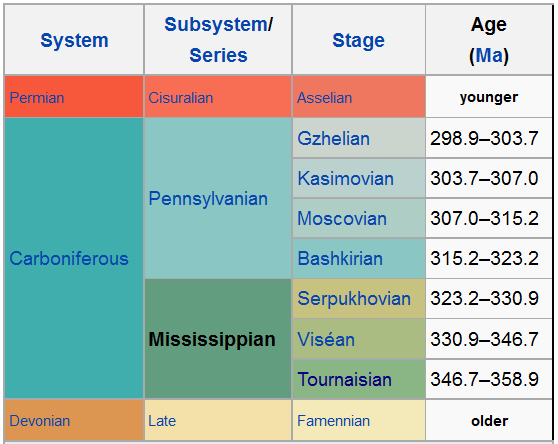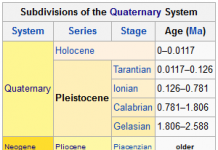The Mississippian is a subperiod in the geologic timescale or a subsystem of the geologic record. It is the earliest/lowermost of two subperiods of the Carboniferous period lasting from roughly 358.9 ± 0.4 to 323.2 ± 0.4 million years ago. As with most other geochronologic units, the rock beds that define the Mississippian are well identified, but the exact start and end dates are uncertain by a few million years. The Mississippian is so named because rocks with this age are exposed in the Mississippi River valley.
The Mississippian was a period of marine ingression in the Northern Hemisphere: the ocean stood so high only the Fennoscandian Shield and the Laurentian Shield stood above sea level. The cratons were surrounded by extensive delta systems and lagoons, and carbonate sedimentation on the surrounding continental platforms, covered by shallow seas.
In North America, where the interval consists primarily of marine limestones, it is treated as a geologic period between the Devonian and the Pennsylvanian. During the Mississippian an important phase of orogeny occurred in the Appalachian Mountains. It is a major rock building period named for the exposures in the Mississippi Valley region. The USGS geologic time scale shows its relation to other periods.
In Europe, the Mississippian and Pennsylvanian are one more-or-less continuous sequence of lowland continental deposits and are grouped together as the Carboniferous system, and sometimes called the Upper Carboniferous and Lower Carboniferous instead.
Subdivisions
In the official geologic timescale, the Mississippian is subdivided into three stages:
- Serpukhovian (330.9 ± 0.2 to 323.2 ± 0.4 mya)
- Visean (346.7 ± 0.4 to 330.9 ± 0.2 mya)
- Tournaisian (358.9 ± 0.4 to 346.7 ± 0.4 mya)
- Chesterian (top of the Visean plus the Serpukhovian)
- Meramecian (middle Visean)
- Osagean (top of the Tournaisian and bottom of the Visean)
- Kinderhookian (the lower two-thirds of the Tournaisian)











